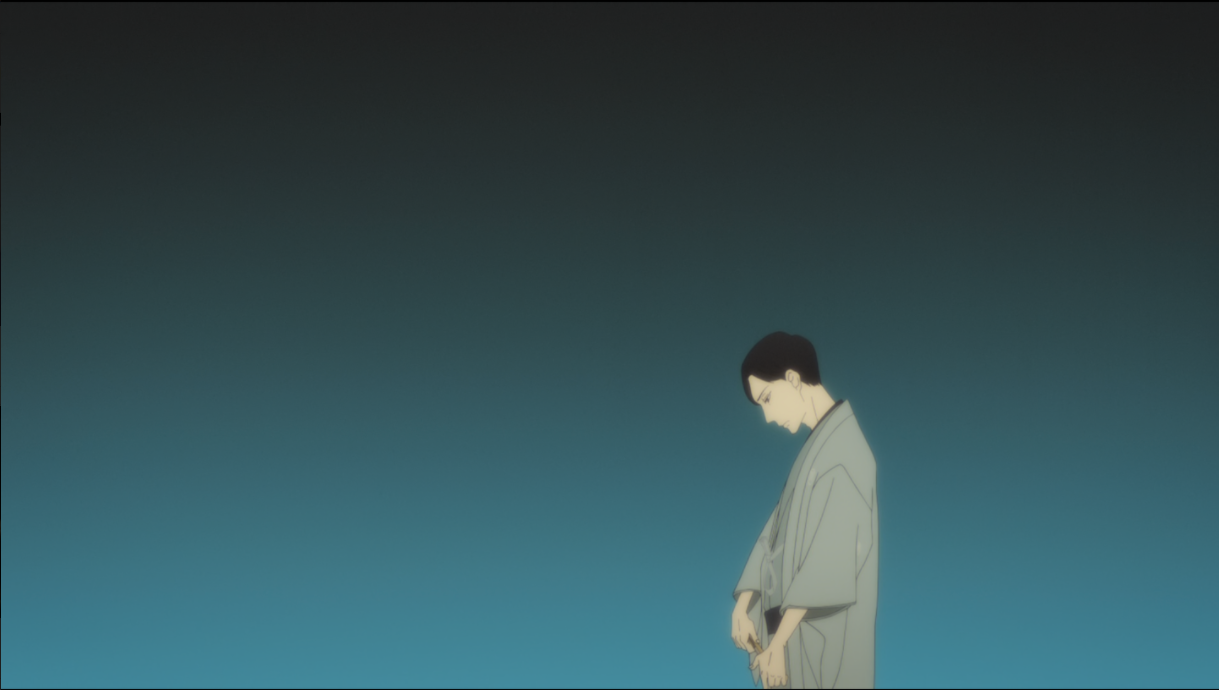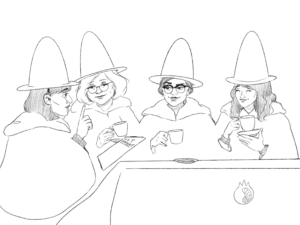On stage, an actor can be just about anything they want. They can go far, far beyond the sky and deep into space, or even down into the very depths of the earth. They can even be the gods themselves. There is truly no limit to where, who, or what they can be.
This is particularly true for the traditional Japanese entertainment form rakugo. Rakugo is a form of stage acting, where the rakugoka, or storyteller, is limited to formal kneeling on stage with very few props. Every role in a given story is portrayed by the rakugoka, and each character is differentiated through varying voices and body language. In effect, the rakugoka can quite literally be anyone and everyone. It’s with this kind of freedom that a father and daughter from Haruko Kumoto’s ode to the art of rakugo storytelling, Shouwa Genroku Rakugo Shinjuu, escape the gender roles placed upon them.

The first character to take center stage is Yuurakutei Kikuhiko. We’re initially introduced to him as one of the most famous rakugoka of the time, but as it turns out, he wasn’t always such a master. Kumoto throws us back into his past for season one, where we see how he rose to stardom. As a child, he grows up working with geisha, training with them in traditional music and dance until a fateful leg injury prevents him from pursuing the career any further. But even if he hadn’t taken that fall, the road towards geisha work would have been fraught with far more barriers. While being a geisha didn’t necessarily start as a career exclusive to women, it certainly became that way, barring Kikuhiko from advancing towards his goals.

To guarantee her son a future, Kikuhiko’s mother apprentices him to Yuurakutei Yakumo, a famous rakugo storyteller. Rakugo, unlike geisha work, is a career traditionally for men (though like every supposedly gendered career, documented exceptions exist, even if the show does not touch on them). From the start, it’s clear that Kiku can’t fit himself into the rakugo mold. Everywhere he turns, he’s cutting and bruising himself trying to shape himself into something he isn’t.

Ultimately, he is unable to grasp at the core of rakugo that his fellow apprentices seem to slip into so easily. Where before he was taught delicacy, he now feels pressured to emulate the masculinity of his teachers and peers. For all intents and purposes, rakugo is a means of survival for him, but not the art that he so greatly misses.

Or at least, that’s how he feels until he takes part in a stage play organized by his peers. He’s cast as one of the two leads, a man disguising himself as a woman. At first, he’s nervous and clearly uncomfortable by his casting. His girlfriend, Miyokichi, offers to help, and he immediately regrets saying anything at all. Waiting for his cue minutes before the play begins, he nearly decides to back out. This is going against everything he’s tried to shape himself into. And then he gets on stage, and it’s a revelation.


Kikuhiko slips right into the role like he was made for it. The audience eats up his performance more than they ever did with rakugo, and suddenly everything clicks into place. In this role, he can be both himself the man and the self that grew up appreciating and aspiring to the feminine. While on stage, he does not have to emulate the men that surround him in life. While on stage, he can be whoever he wants. And whoever he wants to be includes the self deep inside him that the world denied him so long ago. And it is this acceptance of himself on the stage that leads to his success.


Konatsu, Kikuhiko’s adoptive daughter, also finds herself shoved into gendered expectations that she can’t quite manage to fit into. From a young age, she’s immersed in the world of rakugo from her biological father, Sukeroku (Kikuhiko’s fellow apprentice and best friend… um, I mean love interest). And she loves it. She loves the stories and the show and the stage with her whole entire heart, imitating her father and his style of rakugo from the moment she can talk.

Of course, there’s a catch. Actually, two. First, Konatsu faces the great, looming wall of rakugo’s male exclusivity. Or rather, the wall Kikuhiko imposes within days of meeting her, continuing to do so for the majority of her life. To him, a female rakugoka calls Kikuhiko’s decision to take on the more feminine stories into question, and so it is imperative that he prevents her from taking the stage. After all, if a woman can do his stories, what need is there for him, a man, to perform them? So, from the time she’s five to the time she’s a full grown adult, he shoots disparaging comments at her for being a tomboy, for being disobedient, for wasting her beauty. Comments like those stick, and the wall between Konatsu and her passion grows ever bigger.


To add on to that, her mother’s distaste for rakugo and personal gendered trauma haunt Konatsu’s every choice. Kikuhiko’s now ex girlfriend Miyokichi is Konatsu’s mother, and to sum up, Kikuhiko broke up with her, so she takes her revenge by getting together with his best friend (again, cough, love interest, cough), Sukeroku. From that point on, she’s absolutely despised rakugo. Every story is a reminder to her of Kikuhiko and a reminder of her own trauma surrounding womanhood.

In Miyokichi’s worldview, there is a specific role that women must take for men, and it’s a role she’s lived all her life. As she says herself, all she’s ever wanted is to be a woman by a man’s side, supporting him, all in order to keep herself alive. Being Miyokichi’s daughter and living in a household fraught with her struggles to maintain the role of “woman,” Konatsu picked these ideas up and internalized them into her everyday life.



Being continually discouraged on all sides both from being herself and doing something she loves with all her heart takes its toll. By the time she’s a full grown adult, she feels shut out from the world she’s dedicated herself to, all because she’s a woman. In order to stay close to her passion though, Konatsu turns to her mother’s solution: become the woman supporting from the sidelines, the man in this case being her own son.

Except like all passions, it’s hard to remain in such a secondary role, and with the continued encouragement of her husband and son, Konatsu takes the stage in front of people for the first time. And like Kikuhiko, everything clicks into place. On stage, she’s no longer trapped in her mother’s and Kikuhiko’s expectations. On stage, she can call upon her father’s rakugo style. On stage, she can be accepted and herself.



Navigating the roles pre-set by generations before you can at times be both painful and a hindrance to self-acceptance and expression. Shouwa Genroku Rakugo Shinjuu depicts this journey through multiple generations, and how much work it takes to arrive at a place of peace. While the road is difficult and often fraught with conflict, the end result is always more than worth it. After all, it’s with acceptance that love, both for the self and for others, can bloom.


Images in this article via Studio Deen’s Shouwa Genroku Rakugo Shinjuu, via Crunchyroll.




